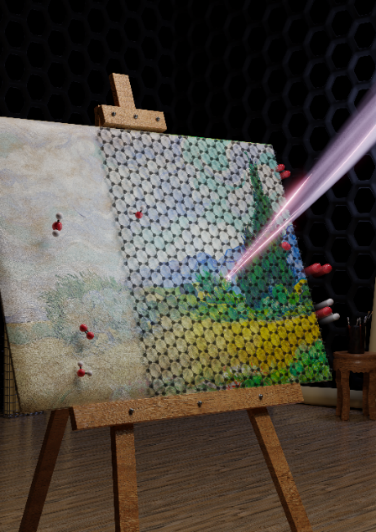A research article was published today in Nature Nanotechnology journal which paves the way for new methods of art conservation by the Nanotechnology and Advanced Materials Laboratory.
The innovative idea of using graphene veils as protective shield on paintings was published today (01.07.2021) in a journal with one of the highest impact factors worldwide, the Nature Nanotechnology. This important research work was carried out, with the guidance of Professor Costas Galiotis, at the Nanotechnology and Advanced Materials Laboratory at the Institute of Chemical Engineering Sciences of Foundation for Research and Technology-Hellas (FORTH/ ICE-HT), in collaboration with the Department of Chemical Engineering of the University of Patras, and the Center for Colloid and Surface Science (CSGI) of the University of Florence. Co-authors of this research study are Maria Kotsidi, Dr. George Gorgolis, Dr. Maria Giovanna Pastore Carbone, Dr. George Anagnostopoulos, George Paterakis, Dr. Tasos Manikas, and Dr. George Trakakis (FORTH & University of Patras) and Dr. Giovanna Poggi and Professor Piero Baglioni from the University of Florence.
 Preventing colour fading in artworks with graphene veils
Preventing colour fading in artworks with graphene veils
Modern and contemporary art materials are generally prone to degradation after exposure to ultraviolet and visible light, moisture and oxidizing agents. The consequence of the above degradation mechanisms is fading, yellowing and colour changes which result in the severe and irreversible alteration of artworks, which are inestimable legacies of mankind. The coatings and varnishes that are currently used for the protection of paintings are unacceptable solutions, since their removal requires the use of solvents that destroy the surface of the artwork.
In this research article it is shown, for the first time, that the graphene veil can be deposited over paintings to efficiently protect them against colour fading. Graphene is a wonder nanomaterial, which was discovered in 2004 by Geim and Novoselov from the University of Manchester (Nobel Prize in Physics in 2010) and has gained widespread research interest due to its excellent properties. The graphene veil used in this research work is a flexible, transparent membrane which is produced in large dimensions through the method of chemical vapor deposition. Based on the results of the published article, it is indicated that the graphene membrane is impermeable to moisture, oxidizing agents and other harmful pollutants, while absorbing the harmful ultraviolet light. Thanks to these properties, along with the fact that graphene can be removed from the surface of art pieces without causing any damage, graphene appears to be the ideal material for the protection of paintings which are exhibited at museums and galleries, as well as during their storage and transportation.
Article in Nature Nanotechnology: (https://www.nature.com/articles/s41565-021-00934-z)
More information:
Costas Galiotis, Professor of the Department of Chemical Engineering of the University of Patras and collaborating faculty member of FORTH/ICE-HT.
Tel: +30 2610-965236, email: galiotis@chemeng.upatras.gr
